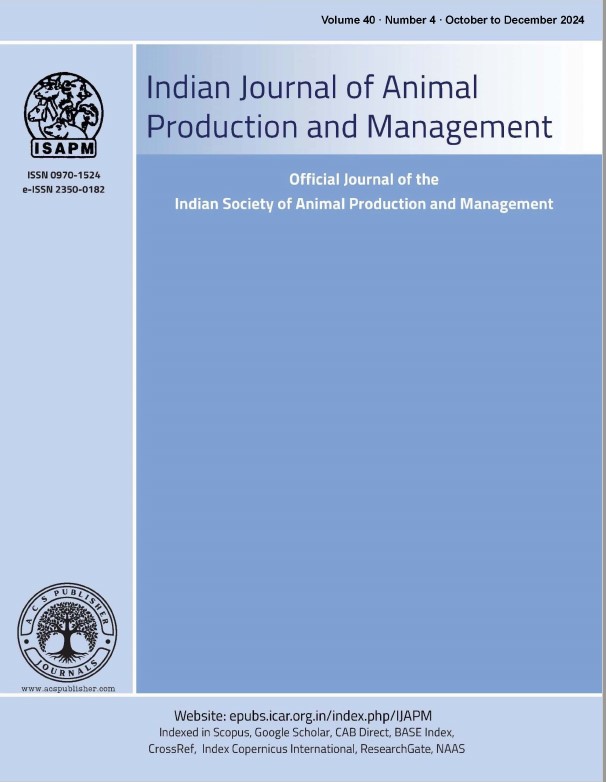Study of Existing Barn and Animal Hygiene Practices in Milch Cows and Buffaloes in Sabarkantha District
DOI:
https://doi.org/10.48165/ijapm.2023.37.4.8Keywords:
Milking hygiene, barn hygiene, mastitis, milking management, buffaloesAbstract
This study aimed to investigate the dairy farming practices and management in Sabarkantha district. A total of 90 livestock owners were randomly selected from six villages representing the Himatnagar, Idar, and Prantij talukas, encompassing three farm size categories based on the number of milch animals: Category A (<10 Milch animals), Category B (10-20 Milch animals), and Category C (>20 Milch animals). The herd composition analysis revealed that cattle were the primary milch animals in the studied farms, with an average total herd strength of approximately 20 cattle and 5 buffaloes. The respondents' personal characteristics indicated a relatively good level of education, with 32% having attained a graduate level of education. The majority of farmers fell into the 50-65 years age group, and most had more than 10 years of experience in dairy farming. Analysis of milking and healthcare practices revealed that a significant number of farmers employed the knuckling method of milking, which is not recommended. Dry cow therapy and milking parlour usage were less prevalent, but proper drying periods and vaccination and deworming practices were generally followed. Housing practices indicated that most farmers used pacca (concrete) floors and provided adequate light and ventilation. Single-line housing was the most popular system, and drainage facilities were generally adequate. However, milking hygiene practices were found to be suboptimal, with limited use of teat dips or antiseptic udder washing. Overall, the study highlights the need for improvement in milking hygiene practices, along with targeted interventions to enhance dairy management in Sabarkantha district.
References
Gadhavi, D. N., L. M. Sorathiya and Rathva, A. L. 2020b. Study of Comparative Aspects Pertaining to Milking Management and Marketing Practices in Specialized Dairy Farms of North and South Gujarat Regions. International Journal of Current Microbiology and Applied Sciences. 9(04): 1694-1700.
Gadhavi, D. N., Sorathiya, L. M., Sabapara, G. P. and Rathva, A. L. 2019. Comparison of herd composition and infrastructure facilities in specialized dairy farms between north and south Gujarat. Indian Journal of Animal Production and Management. 35 (3-4): 61-65.
Gadhavi, D.N., Sorathiya, L.M. and Rathva, A.L. 2020a. Comparative Socio-Economic and Personal Characteristics of Specialized Dairy Farms of North and South Gujarat
Regions. Indian Journal of Veterinary Sciences & Biotechnology. 15(3): 9-12.
McDaniel, C. J., Cardwell, D. M., Moeller, R. B., and Gray, G. C. 2014. Humans and cattle: a review of bovine zoonoses. Vector-Borne and Zoonotic Diseases, 14(1): 1-19.
Mir, A. Q., Bansal, B. K., and Gupta, D. K. 2014. Subclinical mastitis in machine milked dairy farms in Punjab: prevalence, distribution of bacteria and current antibiogram. Veterinary World, 7(5).
Norberg, P. 2012. Effects of rubber alley flooring on cow locomotion and welfare. M.V.Sc. thesis submitted to department of animal nutrition and management, Swedish University of agricultural sciences. (https://core.ac.uk/reader/11989360).
Oliveira, L., Hulland, C., and Ruegg, P. L. 2013. Characterization of clinical mastitis occurring in cows on 50 large dairy herds in Wisconsin. Journal of dairy science, 96(12): 7538-7549.
Patel, N.B., Raval, A.P., Sabapara, G.P. and Padheriya, Y.D. 2020. Personal and socio economic profile of dairy farmers and Prevailing housing management practices for dairy animals in Navsari district of Gujarat. Indian J. Anim. Prod. Mgmt. 36 (3-4): 101-105.
Patel, P.C., Sabapara, G.P. And Sorathiya, L. M. 2018. Housing management practices followed by dairy animal owners in Valsad district of Gujarat. Indian J. Anim. Prod. Mgmt.
(3-4): 7-13.
Patel, T.P., Sorathiya, L.M., Kapadiya, F.M., Makawana, P.P. and Chaudhary, G.R. 2020. Dairy husbandry practices by women dairy farmers in Sabarkantha district of Gujarat. The Pharma Innovation Journal, SP-9(4): 144-
Rathore, R.S., Dayanand, Khan, R. And Nagar, V. 2020. Adoption of recommended calf rearing, milking and health care management practices by the cross bred cattle owners. Indian J. Anim. Prod. Mgmt. Vol. 36 (3-4): 6-11.
Rathva, A.L. and Sorathiya, L.M. (2020). Prevailing Housing and Healthcare Management Practices in Urban and Peri Urban Dairy Farms of Navsari District, Gujarat State. Ind J Vet Sci and Biotech, 15(4): 15-18.
Rathva, A.L., Sorathiya, L.M. and Sabapara, G.P. 2019. Milking Management Practices Followed at Commercial Dairy Farms in Urban and Peri-Urban Areas of Navsari District of Gujarat. Veterinary Research International.
(4):263-266.
Snedecor, G. W., and Cochran, W. G. 1990. Statistical Methods, edn 7th Iowa State University Press. Iowa, USA.
Sprecher, D.E.A., Hostetler, D.E. and Kaneene, J.B. 1997. A lameness scoring system that uses posture and gait to predict dairy cattle reproductive performance. Theriogenology, 47(6): 1179-





